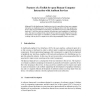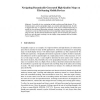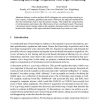GI
2008
Springer
14 years 19 days ago
2008
Springer
GI
2008
Springer
14 years 19 days ago
2008
Springer
: For the deployment of ambient services it is unrealistic to base user-computer interaction on traditional mouse or keyboard. Replacing them with other proprietary devices just mo...
GI
2008
Springer
14 years 19 days ago
2008
Springer
Abstract: On mobile devices, navigating in high-resolution and high-density 2D information spaces, such as geographic maps, is a common and important task. In order to support this...
GI
2008
Springer
14 years 19 days ago
2008
Springer
GI
2008
Springer
14 years 19 days ago
2008
Springer
: This paper presents a printed near field communication system that can be integrated into everyday objects, like paper products or plastic parts. The interface is realised by hi...
GI
2008
Springer
14 years 19 days ago
2008
Springer
GI
2008
Springer
14 years 19 days ago
2008
Springer
GI
2008
Springer
14 years 19 days ago
2008
Springer
: Dealing with context information is an important concern for mobile service computing. However, modern frameworks and programming languages do not directly support context-depend...
GI
2008
Springer
14 years 19 days ago
2008
Springer
Abstract: In this paper, we describe a prototype of an adaptive indoor navigation system which is based on mobile devices and navigates visually impaired people through an unknown ...
GI
2008
Springer
14 years 19 days ago
2008
Springer
: Combining GPS tracks with semantic annotations is the basis for large data analysis tasks that give insight into the movement behavior of populations. In this paper, we present a...





